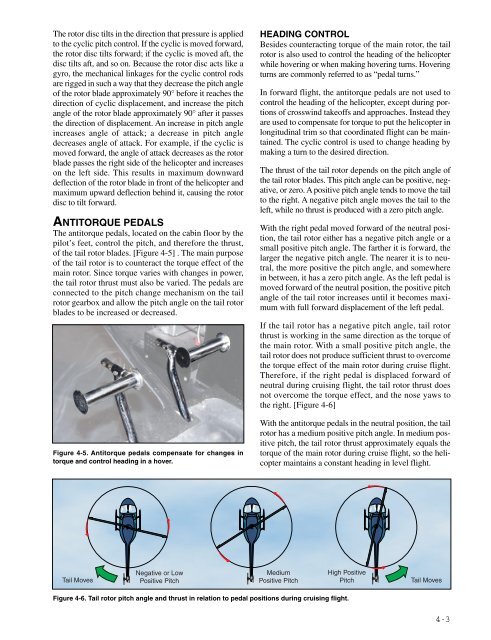Rotorcraft Flying Handbook, FAA-H-8083-21
Rotorcraft Flying Handbook, FAA-H-8083-21
Rotorcraft Flying Handbook, FAA-H-8083-21
Create successful ePaper yourself
Turn your PDF publications into a flip-book with our unique Google optimized e-Paper software.
The rotor disc tilts in the direction that pressure is applied<br />
to the cyclic pitch control. If the cyclic is moved forward,<br />
the rotor disc tilts forward; if the cyclic is moved aft, the<br />
disc tilts aft, and so on. Because the rotor disc acts like a<br />
gyro, the mechanical linkages for the cyclic control rods<br />
are rigged in such a way that they decrease the pitch angle<br />
of the rotor blade approximately 90° before it reaches the<br />
direction of cyclic displacement, and increase the pitch<br />
angle of the rotor blade approximately 90° after it passes<br />
the direction of displacement. An increase in pitch angle<br />
increases angle of attack; a decrease in pitch angle<br />
decreases angle of attack. For example, if the cyclic is<br />
moved forward, the angle of attack decreases as the rotor<br />
blade passes the right side of the helicopter and increases<br />
on the left side. This results in maximum downward<br />
deflection of the rotor blade in front of the helicopter and<br />
maximum upward deflection behind it, causing the rotor<br />
disc to tilt forward.<br />
ANTITORQUE PEDALS<br />
The antitorque pedals, located on the cabin floor by the<br />
pilot’s feet, control the pitch, and therefore the thrust,<br />
of the tail rotor blades. [Figure 4-5] . The main purpose<br />
of the tail rotor is to counteract the torque effect of the<br />
main rotor. Since torque varies with changes in power,<br />
the tail rotor thrust must also be varied. The pedals are<br />
connected to the pitch change mechanism on the tail<br />
rotor gearbox and allow the pitch angle on the tail rotor<br />
blades to be increased or decreased.<br />
Figure 4-5. Antitorque pedals compensate for changes in<br />
torque and control heading in a hover.<br />
HEADING CONTROL<br />
Besides counteracting torque of the main rotor, the tail<br />
rotor is also used to control the heading of the helicopter<br />
while hovering or when making hovering turns. Hovering<br />
turns are commonly referred to as “pedal turns.”<br />
In forward flight, the antitorque pedals are not used to<br />
control the heading of the helicopter, except during portions<br />
of crosswind takeoffs and approaches. Instead they<br />
are used to compensate for torque to put the helicopter in<br />
longitudinal trim so that coordinated flight can be maintained.<br />
The cyclic control is used to change heading by<br />
making a turn to the desired direction.<br />
The thrust of the tail rotor depends on the pitch angle of<br />
the tail rotor blades. This pitch angle can be positive, negative,<br />
or zero. A positive pitch angle tends to move the tail<br />
to the right. A negative pitch angle moves the tail to the<br />
left, while no thrust is produced with a zero pitch angle.<br />
With the right pedal moved forward of the neutral position,<br />
the tail rotor either has a negative pitch angle or a<br />
small positive pitch angle. The farther it is forward, the<br />
larger the negative pitch angle. The nearer it is to neutral,<br />
the more positive the pitch angle, and somewhere<br />
in between, it has a zero pitch angle. As the left pedal is<br />
moved forward of the neutral position, the positive pitch<br />
angle of the tail rotor increases until it becomes maximum<br />
with full forward displacement of the left pedal.<br />
If the tail rotor has a negative pitch angle, tail rotor<br />
thrust is working in the same direction as the torque of<br />
the main rotor. With a small positive pitch angle, the<br />
tail rotor does not produce sufficient thrust to overcome<br />
the torque effect of the main rotor during cruise flight.<br />
Therefore, if the right pedal is displaced forward of<br />
neutral during cruising flight, the tail rotor thrust does<br />
not overcome the torque effect, and the nose yaws to<br />
the right. [Figure 4-6]<br />
With the antitorque pedals in the neutral position, the tail<br />
rotor has a medium positive pitch angle. In medium positive<br />
pitch, the tail rotor thrust approximately equals the<br />
torque of the main rotor during cruise flight, so the helicopter<br />
maintains a constant heading in level flight.<br />
Tail Moves<br />
Negative or Low<br />
Positive Pitch<br />
Medium<br />
Positive Pitch<br />
High Positive<br />
Pitch<br />
Tail Moves<br />
Figure 4-6. Tail rotor pitch angle and thrust in relation to pedal positions during cruising flight.<br />
4-3

















